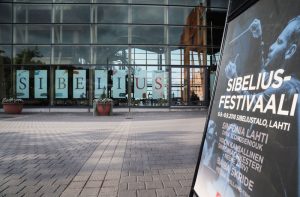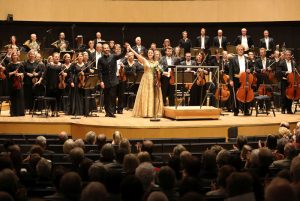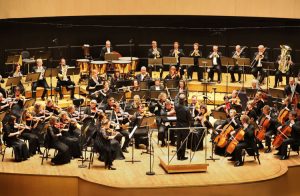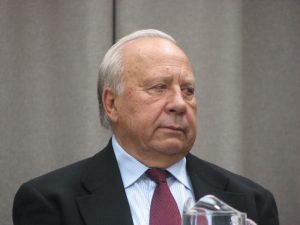
Sibelius One’s group visit to the 2018 Lahti Sibelius Festival was, as always, popular; this year our group numbered some 30 members, who enjoyed not only the festival’s five concerts but also assorted extra events including visits to Hämeenlinna (including the new Sibelius Forest national park) and Ainola (where our AGM was held in Hesan kamari, by kind permission of Ainola’s curator Hanne Selkokari), receptions laid on by Finnish Sibelius societies and our traditional group meal at Lahti’s well-regarded El Toro restaurant.
Compared with the jubilee years 2015 (Sibelius 150) and 2017 (Finland 100), the 2018 festival was relatively low-key, its Baltic theme justified by the presence of a Latvian soloist and an Estonian guest conductor and orchestra. 2018 is moreover the centenary of the Republic of Estonia.

At this year’s festival the Lahti orchestra and Dima Slobodeniouk gave only two concerts, both of them with the Baiba Skride as soloist. She only just made it in time for the first concert, where she played the Violin Concerto, having experienced flight trouble and having arrived too late to rehearse with the orchestra. To the credit of all involved, the lack of rehearsal did not show at all: this was a confident, nuanced and idiomatic performance, with all the technical mastery that the piece demands. That aside, the concert featured relatively rare music: it opened with the Overture in A minor, a rarity written around the time of the Second Symphony and dominated by fanfares at the beginning and end. More refined by far was the music in the second half, the concert suite from the incidental music to Strindberg’s Swanwhite (1908). Its seven short movements offer little scope for interpretative revelation, but they were tastefully played here (the strings in the fifth movement, The Prince Alone, were con sordino, which isn’t indicated in the published score). The encore was more incidental music: a slightly up-tempo version of At the Castle Gate from Pelléas et Mélisande.

The other Lahti Symphony Orchestra concert was on Saturday evening and was unquestionably the highlight of the festival. Right from the outset a sense of rhythmic unstoppability pervaded the funeral march In memoriam – played slowly and steadily. If this piece owed its success to its very inexorability, the Six Humoresques for violin and orchestra that followed explored quite different facets of Sibelius’s genius. To make their full effect these pieces need a soloist who can bring out all of their nuances and contrasts, in terms of both tempo and expressivity, and Baiba Skride rose magnificently to the challenge. In the second half we heard the Sixth and Seventh Symphonies. At Dima Slobodeniouk’s request there was no applause between the symphonies, a decision that was unpopular among Sibelius One members who felt that it was disrespectful to the music. At least there was a slight pause, however (other conductors [Rattle, Segerstam] have played them attacca, even though it makes no sense to have breaks between the movements of the Sixth and nothing at all between two quite separate works). What was impressive in both symphonies, especially the Seventh, was the seamlessness of the music-making; changes of tempo were achieved imperceptibly and with a naturalness that flows from a profound understanding of what Sibelius was trying to achieve. The playing from all sections of the orchestra was strong, colourful, full-blooded and accurate.
As encores we heard the first performance of a new orchestration of Sibelius’s organ Intrada, Op.111a, by Lahti music student Luukas Hiltunen (see separate story: click here) and Finlandia, making a welcome return to its traditional place as the festival’s final encore after last year’s absence.

As for the Friday concert with the Estonian National Symphony orchestra under Neeme Järvi – a massively experienced and respected Sibelius conductor – expectations were high but were soon dashed. The encore (Andante festivo) was well done and the orchestra has a good solo cellist, important in the Fourth Symphony, but the good news stopped there. Järvi’s conducting in the symphonies, though lyrical, was eccentric, impatient and unsteady in tempo. One moment he would prolong a chord or caesura to the utmost; the next moment he would push forwards as if he had a train to catch. The slow movement of the Third was much too fast, unsteady in intonation and lazily phrased, whilst the finale of the Fourth (tubular bells and glockenspiel – predictably not together and sounding rather silly) was just wrong. The changed dynamics in the final chords – the penultimate chord very quiet, the last one very loud – were really in very bad taste. It would seem that the Neeme Järvi who in earlier years delivered so many skilful and well-judged Sibelius performances is a thing of the past; a highly experienced Finnish commentator called the concert ‘mediocre’. The upper strings had problems with blend throughout, the horns – all-important in the Third Symphony – were weak, the brass outbursts in the first movement of the Fourth were unimaginative and half-hearted. There may not have been any major disasters but at no point did the playing sound any better than average, and this 81-member orchestra struggled to fill the Sibelius Hall with sound – something the much smaller Lahti Symphony Orchestra manages with ease.
There were three chamber music events. After the Thursday orchestral concert we heard the Wellamo Trio giving a performance of the ‘Hafträsk’ Trio from 1886. This is the first of two piano trios that Sibelius wrote in the Turku archipelago during his student years and is characterized, especially in the first movement, by Beethovenian vigour – admittedly somewhat underplayed in this interpretation, which lent the music a more Schumannesque veneer. The barcarole-like slow movement is especially appealing. This performance used an edition by Pauliina Pekki which solves some of the manuscript’s riddles but has been criticized by some Finnish scholars who have pointed out that it contains a number of errors.
On Saturday afternoon, at the Kalevi Aho Hall, the Meta4 string quartet introduced and played Voces intimae. The performance was exceptionally fine: blend and balance were judged to perfection; rubato was plentiful but natural; the music proceeded logically and purposefully forward; and despite what must have been meticulous preparation, a feeling of genuine spontaneity was created. The performance was supposed to have been accompanied by a light show, but apart from a change from white to slightly yellow spotlights at the end of the slow movement, nothing of the kind was noticed by the audience.
The festival closed with the usual ‘Sibelius on a Sunday Morning’ concert, and a clear feeling of déjà vu, as it was a repeat of last year’s Sunday morning performance: the five Op. 75 piano pieces named after trees, followed by the Violin Concerto in its violin and piano arrangement, accompanied by two dancers. The violinist was Minna Pensola (a member of Meta4) and the pianist was Heini Kärkkäinen. Some members of the group felt that this was a more refined performance than last year’s.
2019 will mark the twentieth anniversary of the Sibelius Festival in Lahti. Please see our ‘Visit Finland’ page if you would like be part of the Sibelius One group that will attend.
© 2018 Sibelius One Committee